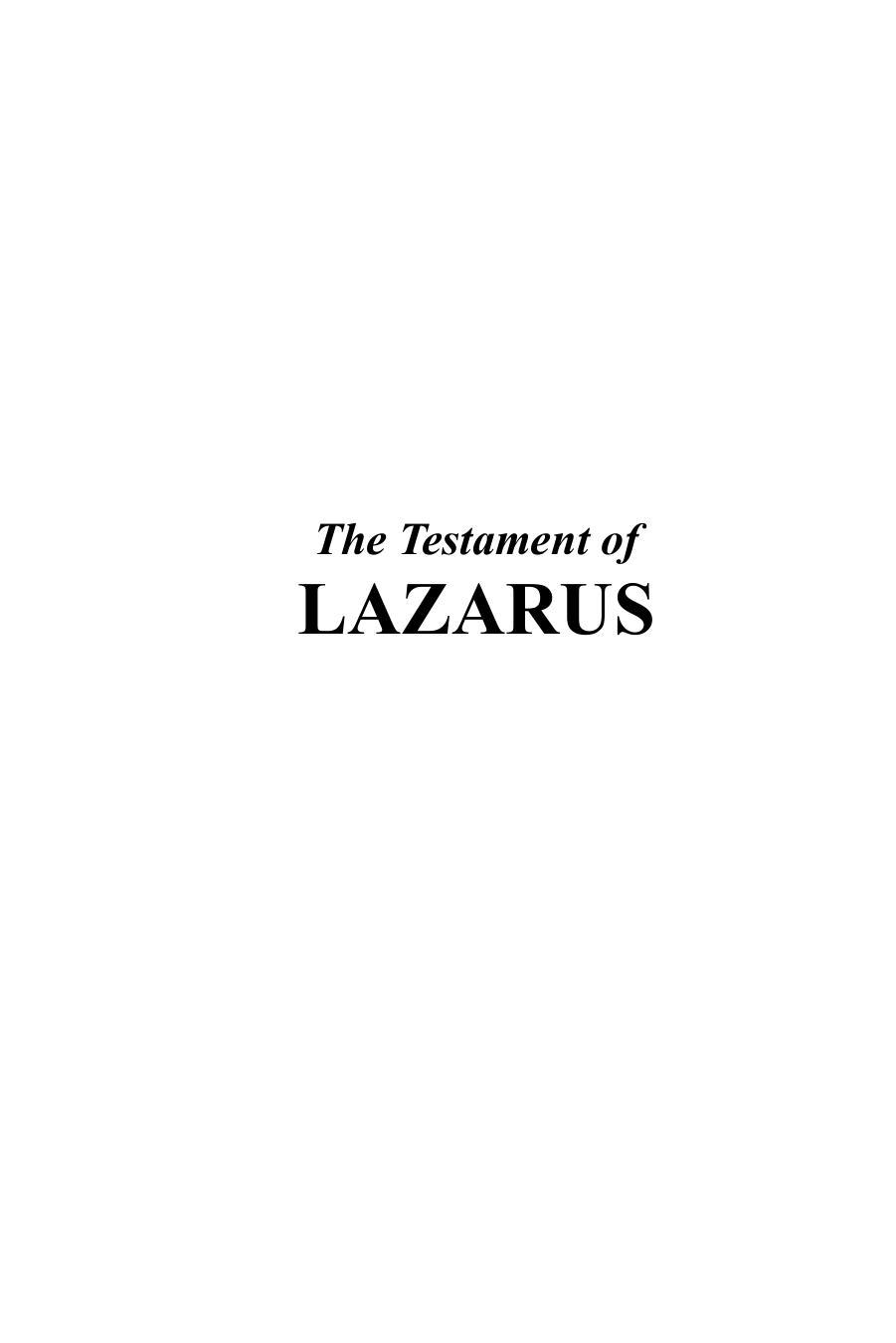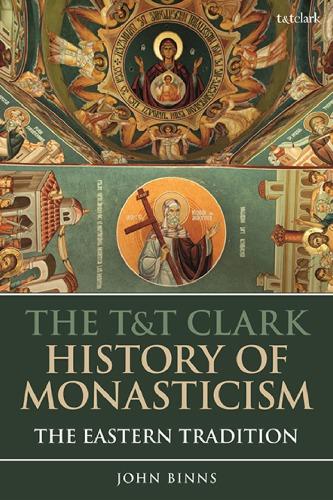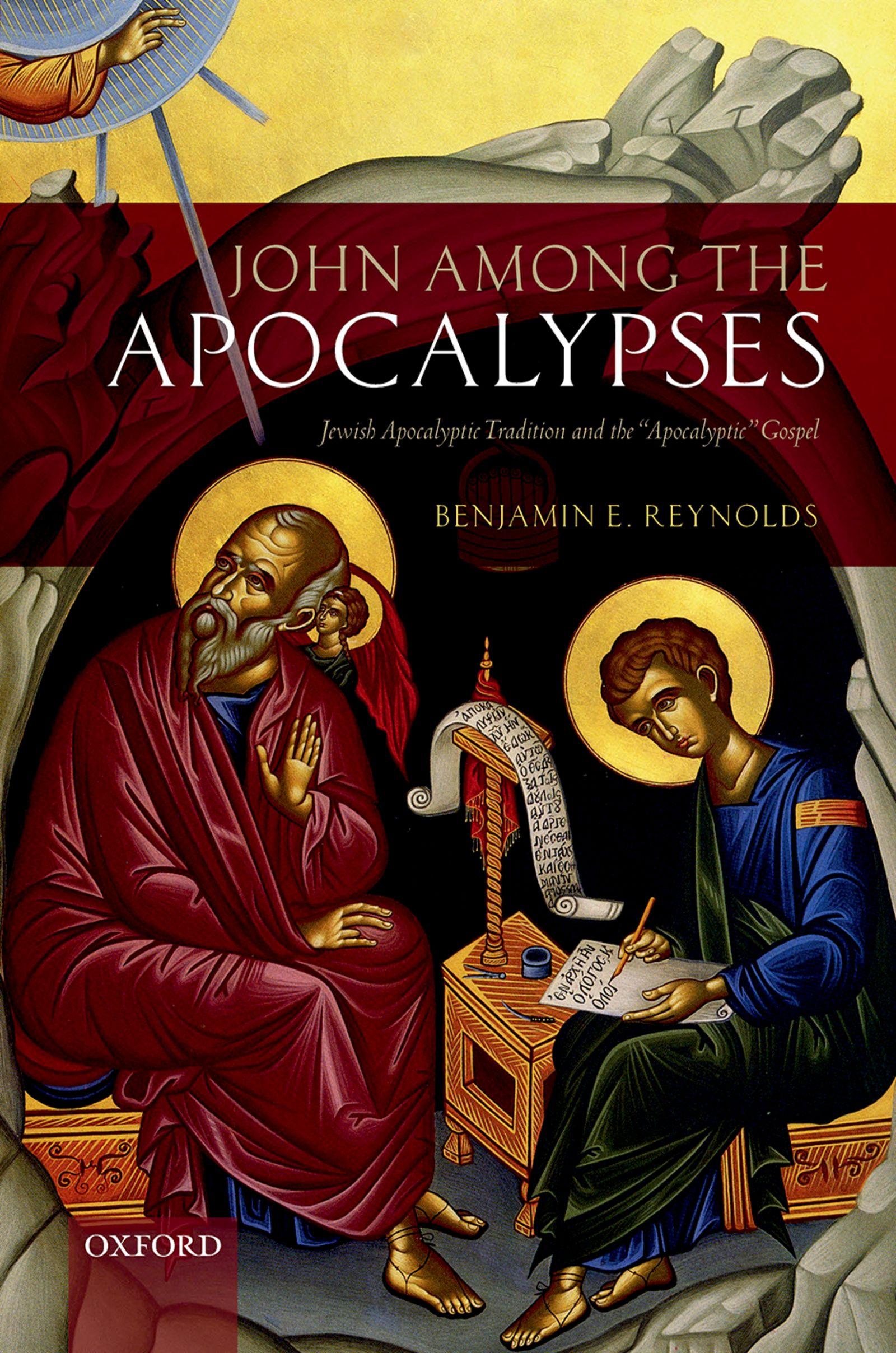John among the Apocalypses: Jewish Apocalyptic Tradition and the 'Apocalyptic' Gospel
Benjamin E. Reynolds
Visit to download the full and correct content document: https://ebookmass.com/product/john-among-the-apocalypses-jewish-apocalyptic-tradi tion-and-the-apocalyptic-gospel-benjamin-e-reynolds/

More products digital (pdf, epub, mobi) instant download maybe you interests ...

The Testament of Lazarus: The Pre-Christian Gospel of John Janet Tyson
https://ebookmass.com/product/the-testament-of-lazarus-the-prechristian-gospel-of-john-janet-tyson/

King John: Shakespeare: The Critical Tradition Joseph Candido (Editor)
https://ebookmass.com/product/king-john-shakespeare-the-criticaltradition-joseph-candido-editor/

Interpreting the Gospel of John in Antioch and Alexandria 1st Edition Miriam Decock
https://ebookmass.com/product/interpreting-the-gospel-of-john-inantioch-and-alexandria-1st-edition-miriam-decock/

Otherness and Identity in the Gospel of John 1st Edition Sung Uk Lim
https://ebookmass.com/product/otherness-and-identity-in-thegospel-of-john-1st-edition-sung-uk-lim/

Becoming John. The Making of a Passion Gospel Syreeni
https://ebookmass.com/product/becoming-john-the-making-of-apassion-gospel-syreeni/

The Gnostic John the Baptizer; selections from the Mandæan John-book, together with studies on John and Christian origins, the Slavonic Josephus' account of John and Jesus, and John and the Fourth gospel proem Mead https://ebookmass.com/product/the-gnostic-john-the-baptizerselections-from-the-mandaean-john-book-together-with-studies-onjohn-and-christian-origins-the-slavonic-josephus-account-of-johnand-jesus-and-john-and-the-fourth-go/

Epicureanism and the Gospel of John: A Study of Their Compatibility Fergus J King
https://ebookmass.com/product/epicureanism-and-the-gospel-ofjohn-a-study-of-their-compatibility-fergus-j-king/

The T&T Clark History Of Monasticism: The Eastern Tradition John Binns
https://ebookmass.com/product/the-tt-clark-history-ofmonasticism-the-eastern-tradition-john-binns/

Governor of the Cordillera: John C. Early among the Philippine Highlanders Shelton Woods
https://ebookmass.com/product/governor-of-the-cordillera-john-cearly-among-the-philippine-highlanders-shelton-woods/

JohnamongtheApocalypses
Johnamongthe Apocalypses
JewishApocalypticTraditionandthe
Apocalyptic” Gospel
BENJAMINE.REYNOLDS
GreatClarendonStreet,Oxford,OX26DP, UnitedKingdom
OxfordUniversityPressisadepartmentoftheUniversityofOxford. ItfurtherstheUniversity’sobjectiveofexcellenceinresearch,scholarship, andeducationbypublishingworldwide.Oxfordisaregisteredtrademarkof OxfordUniversityPressintheUKandincertainothercountries
©BenjaminE.Reynolds2020
Themoralrightsoftheauthorhavebeenasserted
FirstEditionpublishedin2020 Impression:1
Allrightsreserved.Nopartofthispublicationmaybereproduced,storedin aretrievalsystem,ortransmitted,inanyformorbyanymeans,withoutthe priorpermissioninwritingofOxfordUniversityPress,orasexpresslypermitted bylaw,bylicenceorundertermsagreedwiththeappropriatereprographics rightsorganization.Enquiriesconcerningreproductionoutsidethescopeofthe aboveshouldbesenttotheRightsDepartment,OxfordUniversityPress,atthe addressabove
Youmustnotcirculatethisworkinanyotherform andyoumustimposethissameconditiononanyacquirer
PublishedintheUnitedStatesofAmericabyOxfordUniversityPress 198MadisonAvenue,NewYork,NY10016,UnitedStatesofAmerica
BritishLibraryCataloguinginPublicationData Dataavailable
LibraryofCongressControlNumber:2020934979
ISBN978–0–19–878424–1
Printedandboundby CPIGroup(UK)Ltd,Croydon,CR04YY
LinkstothirdpartywebsitesareprovidedbyOxfordingoodfaithand forinformationonly.Oxforddisclaimsanyresponsibilityforthematerials containedinanythirdpartywebsitereferencedinthiswork.
Formyparents
Acknowledgments
Thereisasmall,butgrowinginterestinunderstandingtheFourthGospelin lightofearlyJudaism.Bythisstatement,Idonotmean “earlyJudaismas background” totheGospelnordoImean “JohnandJudaism,” butrather ImeanreadingtheFourthGospelaspartofearlyJudaism.Thisperspective turnsmuchtwentieth-centuryJohanninescholarshiponitshead,butitisthe twentieth-centurydiscoveryoftheDeadSeaScrollsthathasbeentheimpetus behindourenrichedunderstandingsofJudaismduringtheSecondTemple period.ReadingtheGospelofJohnalongsideearlierandcontemporaryJewish literatureopensnew(orrenewed?)avenuesforunderstandingtheFourth Gospel,particularlyinrelationshiptoJewishapocalyptictradition.
Thepresentstudygrewoutofthecolloquiumonthe “GospelofJohnand IntimationsofApocalyptic” hostedbyCatrinWilliamsin2010atthe UniversityofWales,BangorinhonorofJohnAshton.Mypaper “John amongtheJewishApocalypses:RethinkingtheGospelofJohn’sGenre” was dyingaslow,painfuldeathinthequestionandanswerperioduntilJohn Ashtonshiftedtheconversationbyrespondingfavorablywhilealsograciously challengingme.John’sinteractionsparkedmyinterestinthetopicfurtherand beganafriendshipwhichcontinueduntilhisdeath.JohnandIcommunicated backandforthasheworkedonwhatbecamehis finalbook, TheGospelofJohn andChristianOrigins (Fortress,2014),andasIcontinuedworkingonthe GospelofJohn’srelationshipwithJewishapocalypses. Johnagreedtowritea forewordforthepresentvolume,butItooktoolongtocompletethisproject andheleftustoosoon.However,IimagineJohn’scommentswouldhave soundedsimilartohisresponsetosomeofmyearlierwork: “itwon’tsurprise youtohearthatIagreewithmuchofwhatyousay.Butitwon’tsurpriseyou eithertohearthatIdohavesomedisagreementsalso,andIthinkIoweitto youtospelltheseout.” IamgratefultoJohnforhisforthrighthonesty,his encouragement,hiscontributiontoJohanninescholarship,andhisfriendship. TherearenumerouspeoplewhomIwouldliketothankfortheiradviceand encouragementonthepresentvolume.IamgratefultoJohnAshtonandJörg Freyforofferingfeedbackonmypreliminaryoutlineforthisproject.Iwould alsoliketothankthosewhoreadachapterormoreofthepresentvolumeand inmanyinstanceschallengedmetorethinkanargumentorsavedmefrom
someembarrassingoversights.Theseincludecolleagues:IanBoxall,Joseph Dodson,NatashaDuquette,SimonGathercole,JonathanMoo,StaceyMoo, IanScott,andCatrinWilliams;andsomeformerandcurrentstudents: MorganClark,SpencerHealey,BenKlassen,andRachelVanderVeen.Of course,thosemistakesthatremainareminealone.Iamalsogratefulto RachelVanderVeenforcompilingtheListofAbbreviationsandtoMarina Hannaforrecreatingthetableof “master-paradigm” elements.
IwouldalsoliketothankallthosewhowerepresentattheBangor Colloquiumin2010,particularlyJohnAshton,IanBoxall,AprilDeConick, JörgFrey,JuttaLeonhardt-Balzer,JudithLieu,ChristopherRowland,Loren Stuckenbruck,andCatrinWilliams,fortheintellectuallystimulatingmeeting thatitwas.Iamgratefultootherswhohaveheardandcommentedonpaper presentationsthathavebeenincorporatedintothisvolume,whichIgavein theinterveningyearsattheSixthEnochSeminar(Milan,June2011);the JohannineLiteratureSection,SBLAnnualMeeting(Chicago,2012);Wisdom andApocalypticismSectionandJohannineLiteratureSectionjointsession, SBLAnnualMeeting(SanDiego,2014).
Iamgratefultothepublishers Bloomsbury,Brill,FortressPress,and MohrSiebeck forpermittingmetoreusematerialfrompreviouslypublished essays.Inmostcases,Ihavesignificantlyreworkedthematerial,butinafew instances,thedetailedargumentmaybefoundintheoriginalpiece:
“JohnandtheJewishApocalypses:RethinkingtheGospelofJohn’sGenre.” In John’sGospelandIntimationsofApocalyptic,editedbyCatrinH.Williamsand ChristopherRowland,36–57.London:BloomsburyT&TClark,animprintof BloomsburyPublishingPlc.,2013.(IncorporatedintoportionsofChapters2 and5.)
“ApocalypticismintheGospelofJohn’sWrittenRevelationofHeavenly Things.” EarlyChristianity 4,no.1(2013):64–95,publishedbyMohr Siebeck,Tübingen.(IncorporatedintoportionsofChapters2,3,and6.)
“TheOtherworldlyMediatorsin4Ezraand2Baruch:AComparisonwith AngelicMediatorsinAscentApocalypsesandinDaniel,Ezekiel,and Zechariah.” In FourthEzraandSecondBaruch:ReconstructionaftertheFall, editedbyMatthiasHenzeandGabrieleBoccaccini,175–93.Leiden:Brill,2013. (IncorporatedintoportionsofChapters2and5.)
“ApocalypticRevelationintheGospelofJohn:RevealedCosmology,the VisionofGod,andVisionaryShowing.” In JewishApocalypticTraditionand theShapingofNewTestamentThought,editedbyBenjaminE.Reynoldsand
LorenT.Stuckenbruck,109–28.Minneapolis,MN:FortressPress,2017. (IncorporatedintoportionsofChapters2and3.)
Iamalsogratefulforthepermissionsgrantedtoincludeimagesoficons depictingSt.JohntheTheologiandictatingtohisscribeProchorusthatare includedonthecoverofthisvolumeandinChapter7.
IamgratefultoTyndaleUniversityfortwohalf-yearsabbaticals(winter 2015andautumn2018)duringwhichamajorityofthisbookwasresearched andwritten.Withoutthefreedomfromadministrativeandteachingloads duringthosetwosemesters,Iwouldnothavebeenabletocompletethis project.ThankstothestaffofTyndaleUniversity’sWilliamHorseyLibrary fortheirresearchandteachingsupport,especiallytoHughRendle,Isabella Guthrie-McNaughton,andMonicaDuce.
ThankstotheSisterhoodofSt.JohntheDivine,particularlytoJeanette Strong,SisterDorothy,andSisterSusanneattheGuestHouseandSister MargaretRuthinthelibrary,forthepeacefulstudyspaceforresearchand writingandtheirkindhospitality.TheSisterhoodwillalwaysholdaspecial placeforme,butitdoessoespeciallywiththisprojectbecause,asmythoughts werecoalescingaroundtheGospelofJohn,Jewishapocalypses,andthebook ofRevelation,Inoticedforthe firsttimeanicon(aquitelargewallpainting, mindyou)thatIhadpassednumeroustimesbefore.TheSisterhood’sicon sparkedareceptionhistoryexplorationoftheliteraryandiconographic traditionofSt.John,Prochorus,andtheCaveofRevelation,andthisexplorationledtothecentralpartofChapter7ofthisvolume.
Iwouldalsoliketothanktheanonymousreviewersfortheirhelpful feedback,aswellasTomPerridge,KarenRaith,JohnSmallman,Henry Clarke,andtherestoftheOUPteamfortheirpatienceandexcellentwork onthisvolume.
Last,butnotleast,IwouldliketothankLizzieandourthreeboysfortheir encouragementandpatience,especiallyinthe finalstagesoftheproject(“Dad, didyou finishyourbooktoday?”).IdedicatethisbooktomyparentsMelissa andRogerReynoldsoutofgratitudefortheirunwaveringloveandsupport.
ListofIllustrations xiii
ListofAbbreviations xv Introduction1
1.Genre, “Apocalypse,” andtheGospelofJohn15
2.TheMannerofRevelationinJewishApocalypsesandJohn37
3.TheContentofRevelationinJewishApocalypsesandJohn67
4.TheFunctionofRevelationinJewishApocalypsesandJohn93
5.John’sGospelas “Apocalyptic” Gospel117
6.Interpretingthe “Apocalyptic” GospelwithJewishApocalypses144
7.The “Apocalyptic” GospelandtheApocalypseofJohn167 Conclusion201 AppendixA:TheJewishApocalypses211 AppendixB:TheJewishApocalypsesandtheGospelofJohn212
ListofIllustrations
7.1. St.JohntheEvangelistandProchorus,11thcentury(1059), Codex587m.,fol.1v,MonasteryofDionysiou,MountAthos, Greece.ReproducedcourtesyofthePatriarchalInstitutefor PatristicStudiesinThessaloniki.192
7.2. TheEvangelistJohnandProchoros,1334/35,Codex81, fol.238v,St.JohntheTheologianMonasteryontheisland ofPatmos.ReproducedcourtesyofKatheloumenosand PatriarachikosExarchosPatmos,Kurillos.193
7.3. JohntheTheologianandProchoros,onepanelfrom Four IconsfromaPairofDoors(Panels),PossiblyPartofa Polyptych:JohntheTheologianandProchoros,theBaptism (Epiphany),HarrowingofHell(Anastasis),andSaintNicholas, 15thcentury,possiblyCretan,intheMetropolitanMuseumof Art,NewYork.©CulturalArchive/AlamyStockPhoto.195
7.4. StJohntheEvangelistandProchoros,byEmmanuelLambardos, 1602,intheMuseumofIcons,theHellenicInstituteforByzantine andPost-ByzantineStudiesinVenice,http://www.istitutoellenico.org/ english/museo/index.html.©theHistoryCollection/AlamyStockPhoto.196
ListofAbbreviations
ABAnchorBible
ABDAnchorBibleDictionary,6vols.,ed.DavidNoelFreedman,NewYork, 1992
ABRLAnchorBibleReferenceLibrary
AGJUArbeitenzurGeschichtedesAntikenJudentumsunddesUrchristentums
AJECAncientJudaismandEarlyChristianity
AnBibAnalectaBiblica
ANFAnte-NiceneFathers
ATRAustralasianTheologicalReview
BBETBeiträgezurbiblischenExegeseundTheologie
BBRBulletinforBiblicalResearch
BETLBibliothecaephemeridumtheologicarumlovaniensium
BibBiblica
BISBiblicalInterpretationSeries
BJSBrownJudaicStudies
BMSECBaylor-MohrSiebeckStudiesinEarlyChristianity
BNTCBlack’sNewTestamentCommentaries
BZNWBeiheftezurZeitschriftfürdieneutestamentlicheWissenschaft
CBETContributionstoBiblicalExegesisandTheology
CBQCatholicBiblicalQuarterly
CBQMSCatholicBiblicalQuarterlyMonographSeries
CBSCoreBiblicalStudies
CCConcordiaCommentary
CCRCambridgeCompanionstoReligion
CCSSCatholicCommentaryonSacredScripture
CEJLCommentariesonEarlyJewishLiterature
CRINTCompendiaRerumIudaicarumadNovumTestamentum
CurBRCurrentsinBiblicalResearch
DCLSDeuterocanonicalandCognateLiteratureStudies
DCLYDeuterocanonicalandCognateLiteratureYearbook
DOPDumbartonOaksPapers
DOSDumbartonOaksStudies
ECCEerdmansCriticalCommentary
EJLEarlyJudaismanditsLiterature
ExpTExpositoryTimes
HbibStHerdersBiblischeStudien/Herder’sBiblicalStudies
HBTHorizonsinBiblicalTheology
HNTHandbuchzumNeuenTestament
HTRHarvardTheologicalReview
HTSHarvardTheologicalStudies
ICCInternationalCriticalCommentary
IDBSupInterpreter’sDictionaryoftheBible:SupplementaryVolume,ed. K.Crim.Nashville,1976
IRTIssuesinReligionandTheology
ITCInternationalTheologicalCommentary
ITQIrishTheologicalQuarterly
JAJSupJournalofAncientJudaismSupplements
JBLJournalofBiblicalLiterature
JCTJewishandChristianTexts
JSJJournalfortheStudyofJudaisminthePersian,Hellenistic,andRoman Periods
JSJSupJournalfortheStudyofJudaism,SupplementSeries
JSNTJournalfortheStudyoftheNewTestament
JSNTSupJournalfortheStudyoftheNewTestamentSupplementSeries
JSPSupJournalfortheStudyofthePseudepigraphaSupplementSeries
JTSJournalofTheologicalStudies
KDKerygmaundDogma
LBSLinguisticBiblicalStudies
LECLibraryofEarlyChristianity
LNTSLibraryofNewTestamentStudies
MNTSMcMasterNewTestamentStudies
MSmanuscript
NHMSNagHammadiandManichaeanStudies
NIGTCNewInternationalGreekTestamentCommentary
NovTNovumTestamentum
NovTSupNovumTestamentum,Supplements
NTLNewTestamentLibrary
NTOANovumTestamentumetOrbisAntiquus
NTRNewTestamentReadings
NTSNewTestamentStudies
NTTNewTestamentTheology
OEDOxfordEnglishDictionary
OTPTheOldTestamentPseudepigrapha. 2vols.,ed.JamesH.Charlesworth, NewYork:Doubleday,1983,1985
OTRMOxfordTheologyandReligionMonographs
PMLAProceedingsoftheModernLanguageAssociation
RBLReviewofBiblicalLiterature
RBSResourcesforBiblicalStudies
RechBibRecherchesBibliques
RNTRegensburgerNeuesTestament
RSBReligiousStudiesBulletin
RSRRecherchesdesciencereligieuse
SAAAStudiesontheApocryphalActsoftheApostles
SANtStudiaAarhusianaNeotestamentica
SBLDSSocietyofBiblicalLiteratureDissertationSeries
SBLMSSocietyofBiblicalLiteratureMonographSeries
SBLRBSSocietyofBiblicalLiteratureResourcesforBiblicalStudy
SBLSBSSocietyofBiblicalLiteratureSourcesforBiblicalStudy
SBTStudiesinBiblicalTheology
SCSSeptuagintandCognateStudies
SEÅSvenskexegetiskårsbok
SJsStudiaJudaeoslavica
SNTSSocietyforNewTestamentStudies
SNTSMSSocietyforNewTestamentStudiesMonographSeries
STDJStudiesontheTextsoftheDesertofJudah
SVTPStudiainVeterisTestamentipseudepigraphica
TBNThemesinBiblicalNarrative
THKNTTheologischerHandkommentarzumNeuenTestament
TJTrinityJournal
TSAJTexteundStudienzumantikenJudentum
TZTheologischeZeitschrift
WBCWordBiblicalCommentary
WUNTWissenschaftlicheUntersuchungenzumNeuenTestament
ZNWZeitschriftfürdieneutestamentlicheWissenschaftunddieKundeder älterenKirche
Introduction
Withoutdoubt,theGospelofJohnhasaplaceamongthefourGospelsasa narrativetellingofthelifeofJesus,¹butfromthebeginningofthefourfold Gospel,theGospelaccordingtoJohnhasbeenunderstoodtoberecognizably different,astheeaglesoaringaboveMatthew,Mark,andLuke.Althoughthe GospelofLukeandthelongerendingofMarkrecountJesus’sascensionto heaven(Luke24:51;Mark16:19),JohnframesJesus’slifebypresentinghimas onewhowaswiththeGod “inthebeginning” andwhois “fromabove.” John speaksofJesus’sdescentfromheaven,hisbeingsentbytheFather,andhis returntotheFather.JohnalsoportraysJesusasspeakingtheFather’swords, doingtheFather’sworks,andbeingonewiththeFather.
TherearemanymoredifferencesbetweentheSynopticGospelsandJohn, butthequestionsthatcontinuetopuzzleinterpretersarewhyJohnisdifferent andhowwecanexplainJohn’sdistinctivenessamongtheGospels.Asis oftennoted,ClementofAlexandriareferredtoJohnasa “spiritualgospel” (πνευματικὸν εὐαγγέλιον),incontrastto “thebodily” content(τὰ σωματικὰ) in “theGospels” (Eusebius, Hist.eccl.6.14.7).WhilewhatClementmeantby thatdescriptionisnotentirelyclear,hiscommentisoneoftheearliest acknowledgmentsofJohn’sdifferencefrom,andyetsimilarityto,Matthew, Mark,andLuke.
John’sdistinctivenesshasearneditvariousdescriptorsfromitsmanyinterpreters,suchas “themaverickGospel,”²a “dramatischeErzählung,”³and “the propheticGospel.”⁴ Inaddition,JohnhasbeencomparedwithGnosticism,⁵
¹D.MoodySmith, JohnamongtheGospels,2ndedn(Columbia,SC,2001);andevenamongthe “other” gospels,onwhich,seeLorneR.Zelyck, JohnamongtheOtherGospels:TheReceptionofthe FourthGospelintheExtra-CanonicalGospels,WUNT,II/347(Tübingen,2013).
²RobertKysar, John,theMaverickGospel,3rdedn(Louisville,KY,2007).
³MichaelTheobald, DasEvangeliumnachJohannes.Kapitel1–12,RNT(Regensburg,2009),14–17.
⁴ AnthonyTyrrellHanson, ThePropheticGospel:AStudyofJohnandtheOldTestament,Scholars’ EditionsinBiblicalStudies(London,2006).
⁵ RudolfBultmann, “DieBedeutungderneuerschlossenenmandäischenundmanichäischen QuellenfürdasVerständnisdesJohannesevangeliums,” ZNW,24(1925),100–46.
JohnamongtheApocalypses:JewishApocalypticTraditionandthe “Apocalyptic” Gospel.BenjaminE.Reynolds, OxfordUniversityPress(2020).©BenjaminE.Reynolds. DOI:10.1093/oso/9780198784241.001.0001
mysticism,⁶ drama,⁷ rhetoric,⁸ wisdom,⁹ Greco-Romannovels,¹⁰ thetrial motif,¹¹narrativephilosophy,¹²andthelistgoeson.Manycomparisonshave alsobeenmadetovarioustypesofliteratureandliterarytechniques,¹³includingarecentcomparisonofJohnwithNorthropFrye’sarchetypes.¹⁴ Inaddition,Jo-AnnBrant,GeorgeParsenios,andKasperBroLarsenhavehighlighted variousliterarytechniquesevidentinJohn,fromdramaticdialoguetofarewell andrecognitionscenes.¹⁵ Thelistofcomparisonscontinuesbecause,asHarold Attridgememorablyargues,Johnappearstobendgenre.¹⁶ Withregardto genretheory,thebending,or “skewing,” asRuthSheridanreferstoit,¹⁷ of genremightbeconsideredgenericchange(i.e.,changerelatedtogenre)orthe modificationorextensionofgenre.Modificationofgenrecommonlyoccurs whenauthorscreateanewtextwithintheboundariesofexistinggenre expectationsbutextendthegenrebyplayingwiththosesameexpectations.¹⁸
Whiletheremaybevariousgenre “type-scenes” intheGospelofJohn,itis notablethattheseembeddedgenres(partialgenressetwithinalargergenre)do notfunctionacrosstheentiretyoftheGospel.Forexample,embeddedgenres
⁶ JeyJ.Kanagaraj, “Mysticism” intheGospelofJohn:AnInquiryintoitsBackground,JSNTSup,158 (Sheffield,1998);AprilD.DeConick, VoicesoftheMystics:EarlyChristianDiscourseintheGospelsof JohnandThomasandOtherAncientChristianLiterature,JSNTSup,157(Sheffield,2001).
⁷ Jo-AnnA.Brant, DialogueandDrama:ElementsofGreekTragedyintheFourthGospel (Peabody, MA,2004);alsoBenWitherington,III, John’sWisdom:ACommentaryontheFourthGospel (Louisville,KY,1995),4–5.
⁸ MargaretDavies, RhetoricandReferenceintheFourthGospel,JSNTSup,69(Sheffield,1992).
⁹ MartinScott, SophiaandtheJohannineJesus,JSNTSup,71(Sheffield,1992);WilliamR.G.Loader, JesusinJohn’sGospel:StructureandIssuesinJohannineChristology (GrandRapids,MI,2017).
¹
⁰ MeredithJ.C.Warren, MyFleshIsMeatIndeed:ANonsacramentalReadingofJohn6:51–8 (Minneapolis,MN,2015);Jo-AnnA.Brant, “JohnamongtheAncientNovels,” in TheGospelofJohnas GenreMosaic,ed.byKasperBroLarsen,SANt,3(Göttingen,2015),157–68.
¹¹AndrewT.Lincoln, TruthonTrial:TheLawsuitMotifintheFourthGospel (Peabody,MA,2000).
¹²TroelsEngberg-Pedersen, JohnandPhilosophy:ANewReadingoftheFourthGospel (Oxford, 2017).
¹³MarkW.G.Stibbe, JohnasStoryteller:NarrativeCriticismandtheFourthGospel,SNTSMS,73 (Cambridge,1992).
¹
⁴ BrianLarsen, ArchetypesandtheFourthGospel:LiteratureandTheologyinConversation,T&T ClarkBiblicalStudies(London,2018).
¹
⁵ Jo-AnnA.Brant, John,Paideia(GrandRapids,MI,2011);GeorgeL.Parsenios, Departureand Consolation:TheJohannineFarewellDiscoursesinLightofGreco-RomanLiterature,NovTSup,117 (Leiden,2005);KasperBroLarsen, RecognizingtheStranger:RecognitionScenesintheGospelofJohn, BIS,93(Leiden,2008);GeorgeL.Parsenios, RhetoricandDramaintheJohannineLawsuitMotif, WUNT,I/258(Tübingen,2010).
¹
⁶ HaroldW.Attridge, “GenreBendingintheFourthGospel,” JBL,121/1(2002),3–21;Harold W.Attridge, “TheGospelofJohn:GenreMatters?,” in TheGospelofJohnasGenreMosaic,ed.by KasperBroLarsen,SANt,3(Göttingen,2015),27–45;HaroldW.Attridge, “Genre,” in HowJohnWorks: StorytellingintheFourthGospel,ed.byDouglasEstesandRuthSheridan(Atlanta,GA,2016),7–22.
¹
⁷ RuthSheridan, “John’sGospelandModernGenreTheory:TheFarewellDiscourse(John13 17) asaTestCase,” ITQ,75/3(2010),287–99.
¹
⁸ AlastairFowler, KindsofLiterature:AnIntroductiontotheTheoryofGenresandModes (Cambridge,MA,1982),23–4;HetaPyrhönen, “Genre,” in TheCambridgeCompaniontoNarrative, ed.byDavidHerman(Cambridge,2007),118–19.
inJohnmayincludea “farewellscene” inJohn13–17ora “betrothalscene” in John4,butneither,Iwouldargue,saysmuchaboutJohn3or10or20. Throughoutthisstudy,myconcernwillbewhetherornotwemaydetermine agenericmodethatexplainstheGospelofJohn’ s “genrebending.” Aswillbe discussedmorefullyinChapter1,modesprovidea “thematicandtonal qualification” toagenre,¹⁹ suchasa “comicnovel” ora “romanticcomedy.”²⁰
SpeakingofJohnasa “genremosaic” helpfullyhighlightstheexistenceof various embeddedgenres presentintheGospel,²¹butIcontendthatpaying attentiontothegenericmodeoftheGospelofJohnoffersusabetterwayto explaintheframingofJohn’sGospelasarevelatorynarrativeanditsdistinctivenessfromtheSynopticGospels.²²
CallingJohna “propheticGospel”²³ordescribingitasbeingshapedbythe HebrewBible²⁴ approachesthemodalunderstandingoftheGospelinits entiretyandrecognizestheunderlyingdebtandoverwhelminginfluenceof theScripturesofIsraelonJohn’snarrativeofJesus.²⁵ Attridge’sargumentfor Johnas “dramatic” alsotendstowardamodaldescription,butthefour “dramatic” featuresheoffersasevidencearenotconsistentacrossthe Gospel,particularlythe “delayedexit” and “recognitionscene” whichare foundinonlyafewpassages.²⁶ AdeleReinhartz’sdescriptionofJohnasa “cosmologicaltale” comesmuchcloser,inmyopinion,todescribingthe Gospel’soverarchingheavenlyandrevelatoryperspectiveonJesus’slife.²⁷ TheframingoftheGospelfromtheperspectiveofJesus’sdescentfrom heaven,hisbeingsentfromthepresenceoftheFather,hisspeakingthe wordsoftheFather,hisdoingtheFather’sworks,hismakingtheFather
¹⁹ JohnFrow, Genre,TheNewCriticalIdiom,2ndedn(London,2015),73.
²⁰ Fowler, KindsofLiterature,106–8;Frow, Genre,69–74.Seethesection “GenreTheory” in Chapter1.
²¹SeeKasperBroLarsen,ed., TheGospelofJohnasGenreMosaic,SANt,3(Göttingen,2015).
²²SeeAttridge, “GenreMatters?,” 32–4;Sheridan, “John’sGospel,” 298–9.
²³Hanson, ThePropheticGospel
²⁴ SaeedHamid-Khani, RevelationandConcealmentofChrist:TheologicalInquiryintotheElusive LanguageoftheFourthGospel,WUNT,II/120(Tübingen,2000).
²⁵ SeeAliciaD.MyersandBruceG.Schuchard,eds., AbidingWords:TheUseofScriptureinthe GospelofJohn,SBLRBS,81(Atlanta,GA,2015);CraigS.Keener, TheGospelofJohn:ACommentary,2 vols(GrandRapids,MI,2003),47–51.
²⁶ Attridge, “GenreMatters?,” 34–40.
²
⁷ AdeleReinhartz, TheWordintheWorld:TheCosmologicalTaleintheFourthGospel,SBLMS,45 (Atlanta,GA,1992),16–28;relatedly,Loader, JesusinJohn’sGospel,423–55.Cf.Frey’spost-Easter perspectiveonJesusinJörgFrey, TheGloryoftheCrucifiedOne:ChristologyandTheologyintheGospel ofJohn,trans.byWayneCoppinsandChristophHeilig,BMSEC(Waco,TX,2018).WhileFrey’sview addressesthepost-Easterrecognitionofthedisciples(John2:22;12:16),suchaperspectiveisnot entirelydistinctamongthefourGospels(Luke24:25–7;24:44–6;seethefulfillmentpassagesinMatt. 1–2).
known,andhisreturningtotheFather²⁸ isthemostdistinctivedifference betweentheFourthGospelandMatthew,Mark,andLuke.
WhatisthebestwaytodescribeJohn’sothernessincomparisontothe SynopticGospels,itstendencytowardskewingandbendinggenre,andfrom wheremightthisheavenlyperspectivederive?Weseemto findourselvesback atRudolfBultmann’sriddlesaboutwhattheGospelofJohnreveals,thepoint fromwhichJohnAshton,TroelsEngberg-Pedersen,andWilliamLoaderhave alsobeguntheirstudiesoftheFourthGospel.²⁹ Bultmanncontendedthatthe twosignificantquestionsconcerningJohnare “WhatisJohn’splaceinthe developmentofearlyChristianity?” and “Whatisitscentralvision[zentrale Anschauung],itsbasicconcept[Grundkonzeption]?”³⁰ Hisanswertothe first question MandeanGnosticism hasallbutbeenabandonedinscholarship, particularlyinlightourgreaterawarenessofearlyJudaismfollowingthe discoveryofandscholarshipontheDeadSeaScrollsandtheresultingrenewal ofinterestinotherearlyJewishliterature.Withregardtohissecondquestion, BultmannwascorrecttoarguethatJohn’ s Grundkonzeption isrevelation (Offenbarung)asdisclosedbyJesustherevealerthroughhiswordsand deeds.³¹
WithinJohanninescholarship,revelationiscommonlyrecognizedasthe centralizingfeatureoftheGospelofJohn.Bultmann’sowncommentaryis structuredaroundtheconceptofrevelation,withhistwomajordivisionsof theGospelentitled “Chapters2–12:TheRevelationofthe ΔΌΞΑ tothe World” and “Chapters13–20:TheRevelationofthe ΔΌΞΑ beforethe Community.”³²He,ofcourse,famouslysaidthatJesusistheRevealerbut thatthereisnocontenttotherevelationapartfromrevealingthatheisthe Revealer.³³ManystudiesandcommentariesontheFourthGospel,whether theyexplicitlyfollowBultmann’sleadornot,arealsostructuredaroundthe
²⁸ ThesefeaturesarewhatWilliamLoaderconsidersthecentralstructureoftheGospel.SeeLoader, JesusinJohn’sGospel.
²
⁹ JohnAshton, UnderstandingtheFourthGospel,2ndedn(Oxford,2007),2–11;Engberg-Pedersen, JohnandPhilosophy,1–3;Loader, JesusinJohn’sGospel,2–12.
³⁰ Bultmann, “DieBedeutung,” 100,102.³¹SeeAshton, Understanding,491–529.
³²RudolfBultmann, TheGospelofJohn:ACommentary,trans.byG.R.Beasley-Murray,R.W.N.Hoare, andJ.K.Riches(Philadelphia,PA,1971),vii–xii.
³³Bultmann, “DieBedeutung,” 102;RudolfBultmann, TheologyoftheNewTestament,trans.by KendrickGrobel,2vols(NewYork,1951), ,66.Engberg-Pedersen, JohnandPhilosophy,2,notesthat WilliamWredemadethisexactpointtwentyyearsbeforeBultmann.
conceptofrevelation.Forexample,MichaelTheobalddividestheGospelinto “RevelationoftheSontotheWorld” and “RevelationoftheSontohisOwn.” PaulRainbow’schaptersinclude: “TheRevelationofGod(theFather),”“God’ s Self-RevelationinChrist’sPerson,”“God’sSelf-RevelationinChrist’sWork,” and “TheRevelationoftheFatherintheSonbytheParaclete.”³⁴ Within moderncriticalscholarship,however,Bultmannwasnotthe firsttohighlight revelationasacentralizingthemeoftheFourthGospel.BernhardWeiss commentsonJohanninerevelationinhis LehrbuchderbiblischenTheologie desNeuenTestaments,whichwasoriginallypublishedin1868.Weiss’sstatementssoundeerilyfamiliar: “Asthelivingorganoftherevelationofthe Father,JesusmustknowHimselfassuch,andthispresupposesthatHe perfectlyknowstheFather,whoisrevealedinHisworks.” Andagain: “the contentsofHiswordare,tobesure,withJohnmainlyHimselfagain, i.e. the meaningoftherevelationgiveninHispersonandHisworks.”³⁵ HugoHuber, acontemporaryofBultmann,alsoarguedthatJesusistheRevealerandthat Jesus’swordsandsignsarethemediumofthatrevelation.³⁶ Halfacentury later,GailO’DaynotesthecentralityofrevelationinJohnbutfocusesonthe revelatorynatureofthetext: “Itis...notthecontentofwhatJesussaysbutthe factthatanencounterwiththedivineoccursthatisatthecoreofrevelationin John.”³⁷ Inarecentcommentary,FrancisMartinandWilliamWright,IVhave madeasimilarclaim: “Jesus’ wholelife hisperson,words,anddeeds isa revelationoftheFather,ofhimselfastheSon,andoftheinfinitelovebetween them.”³⁸ PhilipvandenHeedecontinuesthetraditionarguingthatrevelation isacentralcategoryforJohnandthattheformofJesus’srevelationisatthe sametimeitscontent.³⁹ Thesescholarsarepartofalong-standingrecognition withinJohanninescholarshipthatrevelationiscentraltotheGospel.
³⁴ Theobald, Evangelium,27–8;PaulA.Rainbow, JohannineTheology:TheGospel,theEpistlesand theApocalypse (DownersGrove,IL,2014).
³⁵ BernhardWeiss, LehrbuchderbiblischenTheologiedesNeuenTestaments (Berlin,1868).Citations fromtheEnglishtranslationofWeiss’sthirdedition:BernhardWeiss, BiblicalTheologyoftheNew Testament,trans.byJamesE.Duguid,2vols(Edinburgh,1883), ,332,352.MyinteractionwithWeissis indebtedtoJamesM.Boice, WitnessandRevelationintheGospelofJohn (GrandRapids,MI,1970),45.
³⁶ HugoH.Huber, DerBegriffderOffenbarungimJohannes-Evangelium:einBeitragzum VerständnisderEigenartdesviertenEvangeliums (Göttingen,1934),27,84.However,thereisa troublingemphasisontheGospel’snewnessandoppositiontoJewishtheology(57).
³⁷ GailR.O’Day, RevelationintheFourthGospel:NarrativeModeandTheologicalClaim (Philadelphia,PA,1986),39.
³
⁸ FrancisMartinandWilliamM.Wright,IV, TheGospelofJohn,CCSS(GrandRapids,MI,2015),24.
³⁹ PhilippevandenHeede, DerExegetGottes.EineStudiezurjohanneischenOffenbarungstheologie, HBibSt,88(Freiburg,2017),13,25–6.SeealsoMichaelLabahn, OffenbarunginZeichenundWort: UntersuchungenzurVorgeschichtevonJoh6,1-25aundseinerRezeptioninderBrotrede,WUNT,II/117 (Tübingen,2000),283,forJesus’srevelationindeedandword.
Intriguingly,arguments for theexistenceandcentralityofrevelationinthe FourthGospelaretypicallynotforthcominginJohanninescholarship.The mostlikelyreasonforthisisthattherevelatorynatureoftheGospelappears quiteobvious.Jesus’smakingtheFatherknownseemsto fitageneralunderstandingof “revelation” (John1:18),nottomentionthatJesus reveals hisglory (ἐφανέρωσεντὴνδόξαναὐτοῦ,2:11).Inherepiloguetothevolume John’ s GospelandIntimationsofApocalyptic,AdelaYarbroCollinsquestions whetherBultmannwascorrectinhisassessmentofrevelationasthecentral outlookoftheGospelofJohn.Shestates, “Aclosereading[oftheGospelof John]revealsthatthethemesofrevelationandJesusasrevealerareless dominantthanRudolfBultmann,forexample,supposed.”⁴⁰ YarbroCollins viewsJesusnotsomuchasrevealerbutasdelegateforGodandasasalvific figure.ToputthisinmoreexplicitlyJohannineterms,John’sJesusismore Savioroftheworld(4:42)thanrevealersentfromheaven.⁴¹Shesays, “The redeemerdoesnotdescendandascendprimarilytoconveyrevelationbutto savetheworld.”⁴²ThisperspectivecomesoutmoreclearlyinYarbroCollins’ s readingoftheSonofMan’sdescentandascentinlightofthecrucifixion(3:13 with3:14⁴³).Likewise,theascentmentionedin6:62,sheclaims,isnotan ascentbut “equivalenttothe ‘liftingup’,thatis,thecrucifixion.”⁴⁴ Laura Holmes,inherreviewofthevolume,suggeststhatYarbroCollins’scritique concerningtherevelatorynatureofJohnundercutstheprojectofunderstandingthethemeofrevelationintheFourthGospelas “intimationsofapocalyptic.”⁴⁵ IdisagreewithHolmes’sassessmentthatYarbroCollinsundercutsthe projectbecausetherearedifferentunderstandingsof “apocalyptic” atplay
⁴⁰ AdelaYarbroCollins, “Epilogue,” in John’sGospelandIntimationsofApocalyptic,ed.byCatrin H.WilliamsandChristopherRowland(London,2013),307.
⁴¹YarbroCollins, “Epilogue,” 302–3,305. ⁴²YarbroCollins, “Epilogue,” 304.
⁴³Acorrespondencebetween ὑψόω andthecrucifixionmaybeargued,butG.C.Nicholson, Death asDeparture:TheJohannineDescent-AscentSchema,SBLDS,63(Chico,CA,1983),141,listsnofewer than fivemajorinterpretationsofthemeaningof ὑψόω intheGospelofJohn.Thecrucifixionis generallyunderstoodaspartofthemeaningof ὑψόω,butthequestioniswhetherthetermprimarily referstothecrucifixionasJesus’sexaltationorthecrucifixionasthebeginningofhisexaltation,which isthencompletedinJesus’sresurrectionandreturntotheFather.Inmyopinion,theinterpretationof John3:14;8:28;and12:34intermsof2:22;7:39;and12:16indicatesthatthe “liftingup”/exaltationof JesusincludesthecrucifixionbutisnotcompleteduntilhereturnstotheFather.SeeRaymond E.Brown, TheGospelaccordingtoJohn(I–XII):Introduction,Translation,andNotes,AB,29 (GardenCity,NY,1966),146.Foralongerdiscussion,seeBenjaminE.Reynolds, TheApocalyptic SonofManintheGospelofJohn,WUNT,II/249(Tübingen,2008),122–7.Frey, GloryoftheCrucified One,247–51,however,arguesfortheexaltationprimarilythroughcrucifixion.
⁴⁴ YarbroCollins, “Epilogue,” 303,apparentlymissestheword “before” in6:62.Shealsoconnects 1:51tothecrucifixion(301).
⁴⁵ LauraC.S.Holmes, “Reviewof John’sGospelandIntimationsofApocalyptic,EditedbyCatrin H.WilliamsandChristopherRowland,” RBL,2015,https://www.bookreviews.org/bookdetail.asp? TitleId=9697,accessedApril3,2020.
betweenthecontributorstothevolumeandYarbroCollins.⁴⁶ Nevertheless, YarbroCollinsandHolmeshelpfullychallengeJohanninescholarship’soften unsupported assumption thatrevelationistheFourthGospel’ s “zentrale Anschaaung,seineGrundkonzeption.”⁴⁷ Johanninescholarshaveprobably fortoolongassumedthecorrectnessofBultmann’sviewwithoutarguingfor it,eveniffewhavefoundhiscontentionofagnosticRedeemermythoriginfor thatrevelationviable.⁴⁸ YarbroCollins’sandHolmes’scritiqueshighlightthe needtodefine “revelation” andtoargueforitsimportanceintheFourthGospel.
Defining “Revelation”
“Revelation” isgenerallyunderstoodtorefertothemakingknownofsomethingthatwaspreviouslyunknown.Accordingtothe OxfordEnglish Dictionary, “revelation” canalsorefertomakingsomethingknownthatwas merelyunrecognized.Itmayalsorefertotheactorexperienceofsomething unknownbeingmadeknown(i.e., “arevelation”),⁴⁹ a “sourceofenlightenment,” oralsosomethingthatinspiresawe(“TheGospelofJohnisarevelation”).ThesortofrevelationthatisconsideredtobepresentintheFourth Gospelisthegenerallyunderstoodmeaning,namelythatsomethingunknown ismadeknown.However,theoriginofthatrevelationisalsoanimportant partofthedefinition.The OED definitionthatbestdefinestherevelation BultmannreferredtoandwhichIwilluseinthefollowingstudyis: “1.a.)The disclosureorcommunicationofknowledge,instructions,etc., bydivineor supernaturalmeans ”⁵⁰ YarbroCollinsis,Ithink,justifiedinpointingoutthat Johanninescholarstendtoassumethedominanceofthissortofrevelationin theGospelofJohn;however,Ithinksheisincorrecttosuggestthat “revelation” isnotcentraltotheGospelofJohn.Havingdefined “revelation” inthis way,IwillargueforthepresenceandcentralityofrevelationintheGospelin thefollowingsection.
⁴⁶ ItshouldbenotedthatYarbroCollinswasnotinattendanceattheBangorColloquiumandwrote theepilogueinresponsetothecompletedessays.
⁴⁷ Bultmann, “DieBedeutung,” 102.
⁴⁸ Ashton, Understanding,3,referstoBultmann’sMandeanhypothesisas “oneoftheoddestofthe manyremarkablebitsofjetsamthatlittertheshoresofJohanninescholarship.”
⁴⁹ BothBoice, WitnessandRevelation,andO’Day, RevelationintheFourthGospel,addressthe theologicalaspectsofnaturalandsupernaturalrevelationintheiropeningsections.
⁵⁰ OxfordEnglishDictionary (Oxford,2000),http://dictionary.oed.com/entrance.dtl,s.v. “revelation” (emphasismine).MarkusN.A.Bockmuehl, RevelationandMysteryinAncientJudaismand PaulineChristianity,WUNT,II/36(Tübingen,1990),2,definesrevelationsimilarly: “‘Revelation’ designatesa)anydivinedisclosurecommunicatedbyvisionaryorpropheticmeans,orb)themanifestationofheavenlyrealitiesinahistoricalcontext.”
EvidenceofRevelationinJohn
OneofthedifficultieswithtracingtheconceptofrevelationthroughoutJohn isthattherearemultipletermsconnectedtotheconcept,andthesetermsare ofteninterconnectedwithintheGospel’snarrative(e.g.,word,truth,believe, seeing,glory).Evenso,variousinterpretershavepresentedlistsofvocabulary termsrelevanttothethemeofrevelationinJohn.Forexample,HugoHuber liststheNewTestamentrevelationtermsas ἀποκαλύ
δηλόω,and φανερόω,butoftheseJohnonlyuses γνωρίζω, δείκνυμι,and
φανερόω.Huberalsoincludes ἀκούω, βλέπω, θεάομαι, πέμπω,andthe “signconcept,” beforementioningthesubstantives “truth,”“light,”“life,” andother symbolicconceptslike “ way, ”“gate,”“shepherd,”“vine,”“bread,”“waterof life,”“flesh,” and “resurrection.” WhilehedoesseemtolisteveryJohannine conceptunder “revelation,” Huberhighlightstherevelatorycharacterofthese sevenverbsinrelationtoJesus’sspeechandactions.Particularly,henotesthat φανερόω describestheself-revelationinherentinJesus’swork.⁵¹
JamesBoicestatesthat “thewitnessofJesusisrevelation” andalsonotesthe revelatoryuseof φανερό
κνυμι intheFourthGospel.Like Huber,Boicementionstheverbsofsending,coming,seeing,perceiving, hearing,andbelieving.⁵²JohnAshtonincludesamuchlongerlistofterms thanHuberorBoice.Hestates, “EverymajormotifintheGospelisdirectly linkedtotheconceptofrevelation. ”⁵³SaeedHamid-Khani,likeAshton, includesanextensivelist.Alongwiththeverbsalreadylisted,Hamid-Khani lists “aclusterofexpressionswhichunderlietheidea[of ‘revelation’]”
κοή, μαρτυρία,and μαρτυρέω.Hamid-Khanicontendsthatthe “conceptis imbeddeddeeplyintheChristologyoftheFourthGospel.”⁵⁴ Andinone final example,PhilippevandenHeedelistsvarious “Offenbarungsverben” inJohn’ s GospelofwhichJesusisthesubject: λέγω-λαλέω, μαρτυρέω, φανερόω, δείκνυμι,and γνωρίζω. ⁵⁵ Strangely,Huber,Boice,andAshtonstatethatthe verb ἀποκαλύπτω isabsentfromtheFourthGospel,buttheverbispresentin thecitationfromIsa.53:1inJohn12:38(moreonthislaterinthissection). Idonothavespacetotracetherevelatorycharacterofallthevocabularylisted
⁵¹Huber, BegriffderOffenbarung,72–84. ⁵²Boice, WitnessandRevelation,31–4.
⁵³Ashton, Understanding,491–2(emphasisoriginal);similarly,J.TerenceForestell, TheWordofthe Cross:SalvationasRevelationintheFourthGospel,AnBib,57(Rome,1974),43–56.
⁵⁴ Hamid-Khani, RevelationandConcealment,344–5.
⁵⁵ VandenHeede, DerExegetGottes,13.
bythesescholars;⁵⁶ however,Iwillbrieflydrawattentiontosomeinstancesof revelation thatis,the “disclosureorcommunicationofknowledgebysupernaturalmeans”—intheGospelofJohn.Manyoftheseinstancescontain vocabularyincludedintheselists.
TheportrayalofJesusasaheavenly figureintheGospelisdirectlyrelatedto revelation,anditisoneofitsdistinctivemotifs.ThatJesusisa “manfrom heaven”⁵⁷ isevidentfromtheopeninglineoftheGospel.TheWordwaswith Godinthebeginning(πρὸςτὸνθεόν,John1:1,2;17:24);hewasinthebosom oftheFather(1:18).Jesus’soriginisheaven.Heis “fromabove” (3:31;8:23), descendedfromheaven(3:13;6:35),andhascomeintotheworld(1:9;3:19; 9:30;11:27).JesusistheSonofManwhohasdescendedfromheaven(3:13), andheistheBreadofLifewhohasdescendedfromheaven(6:33).Heisthe Sonwhohasbeensentintotheworld(3:17;10:36;17:21),andheistheone comingfromheaven(3:31).Jesus’sheavenlyoriginandeventualreturntohis FatherinheavenframethenarrativeofJesus’slifeandunderlinetheheavenly natureofwhathedoesandsays(6:62;14:2–3,12,28;16:5).⁵⁸
Jesushascomefromheavenandwhathesaysanddoesincludesthe revelationofheavenlythings.Hiswordsandactionscomedirectlyfromthe Father.HespeakstheFather’swords(8:28–9;12:49–50)andtestifiestowhat hehasseenandheardfromabove(3:11,32;8:38,40;15:15).⁵⁹ Jesus’sheavenly origingiveshimtheknowledgeandauthoritytospeakheavenlythingsthathe hasheardfromtheFather(3:11–12,31–6).⁶⁰ Thefactthatheis “fromabove” (3:31)andcanspeakofheavenlythings(τὰἐπουράνια,3:12)indicatesthat divinedisclosureisintegraltoJesus’sactivity.Evenhisworksarerevelatoryin nature.TheFatherhasshowntheSonwhathedoes,andJesusdoesthose thingsthattheFatherhasshownhim(5:19–22).SincethesearetheFather’ s worksthatJesusdoes,theyindicate “God’sself-revelationinJesus.”⁶¹The works,likeJesus’swords,areheavenlyinoriginandarerevealedtothoseon
⁵⁶ On φανερόω,seeHuber, BegriffderOffenbarung,73–4;andChristopherRowlandand ChristopherR.A.Morray-Jones, TheMysteryofGod:EarlyJewishMysticismandtheNew Testament,CRINT,12(Leiden,2009),14;on ἀναγγέλλω,seeCatrinH.Williams, “Unveiling Revelation:TheSpirit-ParacleteandApocalypticDisclosureintheGospelofJohn,” in John’sGospel andIntimationsofApocalyptic,ed.byCatrinH.WilliamsandChristopherRowland(London,2013), 104–27;on δείκνυμι,seeBenjaminE.Reynolds, “ApocalypticRevelationintheGospelofJohn: RevealedCosmology,theVisionofGod,andVisionaryShowing,” in TheJewishApocalyptic TraditionandtheShapingofNewTestamentThought,ed.byBenjaminE.ReynoldsandLoren T.Stuckenbruck(Minneapolis,MN,2017),109–28.
⁵⁷ WayneA.Meeks, “ManfromHeaveninJohannineSectarianism,” JBL,91/1(1972),44–72.
⁵⁸ SeeReinhartz, TheWordintheWorld,29–30.
⁵⁹ Boice, WitnessandRevelation,39–74,arguesthatJesus’stestimonyisprimarilyrevelation.
⁶⁰ Cf.W.H.Cadman, TheOpenHeaven:TheRevelationofGodintheJohannineSayingsofJesus,ed. byG.B.Caird(Oxford,1969),3–14.
⁶¹Ashton, Understanding,497.
earth.Jesus’sworksaretheFather’sworksthathehasshowntoJesus (δεικνύμι,5:19–20;also4:34;5:36;6:29).
ThesignsJesusdoesarepartoftheworksandtestifytohisheavenlyorigin andhisrelationshipwiththeFather;yetMarianneMeyeThompsondisputes therevelatorynatureofthesigns,sayingthattheydonotcontainpreviously unknownthings.ShecontendsthatGodhasprovidedforhispeopleinthepast, andwine,bread,andsightareallearthlythings.⁶²SheiscorrectthatGod’ s provisionandtheearthlyaspectsofthesignsarenotunknown,butthespecific deedsJesusdoespointtosomethingpreviouslyunknownandsomethingnew. Evenifwineisnotrevelatory,Jesus’sdisciplessawsomethingnewinthe turningofwaterintowine,namelyJesus’srevealedglory(ἐφανέρωσεντ
όξαναὐτοῦ,2:11).In9:3,Jesussaysthattheblindnessofthemanbornblind isnotbecauseofsinbut “inorderthatthatworksofGodmightberevealed [φανερωθῇ]inhim.” Jesus’ssigns,whileincludingearthlythingssuchaswine, mud,water,andbread,pointtopreviouslyunknownknowledgeabouthis heavenlyoriginthatismadeknownbyaheavenly figure.⁶³Theyalso “pointthe waytoatruefaithandarethereforerevelatoryinthefullsense”⁶⁴ (20:30).
Jesus,thestrangerfromheaven,⁶⁵ makestheFatherknown(ἐξηγήσατο, 1:18).Whetherthesenseoftheverb ἐξηγήσατο is “reveal,”“guide,”“show,” or “makeknown,”⁶⁶ Jesus,astheonlyonewhohasseentheFatherandbeenwith him,makestheFatherknowninawaythatwasnotpreviouslyknown.⁶⁷ Thus, “revelationisparamountintheexpression.”⁶⁸ NotonlydoesJesusmakethe Fatherknown,buthehasrevealedandmadeknowntheFather’ sname (ἐφανέρωσά σουτὸὄνομα,17:6; ἐγνώρισα τὸὄνομασου,17:26).Jesus’ s revelationoftheFatherismadeplaininJohn14.WhenPhilipasksJesusto showthemtheFather,JesusrepliesthatseeinghimisseeingtheFather (14:8–9).JesusmakestheFatherknownandistherevelationoftheFather. ToknowJesusistoknowtheFather(14:7);toseeJesusistoseetheFather.⁶⁹ JesusisthevisionofGodonearth.⁷⁰
⁶²MarianneMeyeThompson, “SignsandFaithintheFourthGospel,” BBR,1(1991),89–108.
⁶³SeevandenHeede, DerExegetGottes,112,116. ⁶⁴ Ashton, Understanding,496.
⁶⁵ MarinusdeJonge, Jesus:StrangerfromHeavenandSonofGod:JesusChristandtheChristiansin JohanninePerspective,trans.byJohnE.Steely,SBLSBS(Missoula,MT,1977).
⁶⁶ JohnF.McHugh, ACriticalandExegeticalCommentaryonJohn1–4,ICC(London,2009),72–3.
⁶⁷ MarianneMeyeThompson, “Jesus: ‘TheOneWhoSeesGod’ , ” in Israel’sGodandRebecca’ s Children:ChristologyandCommunityinEarlyJudaismandChristianity,ed.byDavidB.Capes,April D.DeConick,andHelenK.Bond(Waco,TX,2007),225–6.
⁶⁸ Keener, GospelofJohn,I,424;alsoHermanRidderbos, TheGospelofJohn:ATheological Commentary,trans.byJohnVriend(GrandRapids,MI,1997),59n.143.
⁶⁹ CraigR.Koester, “JesusastheWaytotheFatherinJohannineTheology(John14,6),” in Theology andChristologyintheFourthGospel:EssaysbyMembersoftheSNTSJohannineWritingsSeminar,ed. byGilbertVanBelle,J.G.vanderWatt,andP.Maritz,BETL,184(Leuven,2005),117–33;Frey, Glory oftheCrucifiedOne,285–312.
⁷⁰ JesusasthevisionofGodwillbediscussedfurtherinChapter3.
FurtherevidenceofrevelationintheGospelofJohnisevidentinJohn1:51. JesusdeclaresthatNathanaelandthediscipleswillseeheavenopenedandthe angelsofGodascendinganddescendingontheSonofMan.Theopeningof heavensuggeststhatwhatwillbeseenincludesheavenlyrevelation.Jesusthe SonofMan,astheoneconnectingheavenandearth,andthusGodand humanity,istherevealeroftheFather.⁷¹
Theconceptsoflight,truth,andgloryalsoreflecttherevelatorynatureof JesusintheFourthGospel.⁷²Jesusisthelightthathascomeintothedarkened world,shinesinthedarkness,andenlightensallpeople(1:4–5,9;3:20–1;8:12; 9:5;12:46).Aswashintedatabove,therevelationofJesus’sgloryispartof Jesus’srevelationoftheFather,becauseJesussharesthegloryoftheFather (2:11;13:31–2;17:1,5).ThegloryseeninJesusistheFather’sglory(12:41), anditisdisclosedthroughJesus’swordsandworks(1:14).Truthisanother revelatorymotifinJohn.Itscloseconnectiontotestimonyanditsreferentis suggestiveoftruththatisdisclosed(1:14,17;5:33;8:40–6).
IntheconclusiontoJohn1–12,the finalactionoftheRevealerinthepublic sphereistohidefromthecrowd(ἐκρύβη ἀ
’
ὐτῶν,12:36;cf.12:34–5).Then theevangeliststatesthattheydidnotbelieveeventhoughhedidmanysigns beforethem(12:37).ThislackofbeliefissaidtofulfillIsaiah’swordsinIsa. 53:1(John12:37–8).Thecitationaskstwoquestions,andCatrinWilliams arguesthatthesecondquestionindicatesthatJesusis “thevisibleembodiment of ‘thearmoftheLord’” (καὶὁ
;, “towhom hasthearmoftheLordbeenrevealed?” 12:38).⁷³Thiscitation,theonly instanceoftheverb ἀποκαλύπτω intheGospelofJohn,summarizesallthat hasproceededinJohn1–12andhighlightsthat,particularlyinhissigns,Jesus istherevealeroftheFather.RevelationisevidentinJohn,andJesusisa heavenly figurewhorevealsthatrevelation.
WhileYarbroCollinsiscorrecttoclaimthattheFourthGospeldownplays heavenlyvision,Idisagreewithhercontentionthatrevelationplaysaless thandominantroleintheGospel,aswellaswithherviewthatJohannine revelationisatoddswithsalvation.⁷⁴ AsIhavehighlightedinthissection, Jesus’srevelationiscentraltotheGospel’snarrative,includingitsrolein salvation.⁷⁵ TheJohannineJesusis “therevealer” becausehedisclosesheavenly things(3:12–13),includingGod’swords,deeds,andtheFatherhimself
⁷¹Hamid-Khani, RevelationandConcealment,346;vandenHeede, DerExegetGottes,211–13.
⁷²Ashton, Understanding,492.
⁷³CatrinH.Williams, “JohannineChristologyandPropheticTraditions:TheCaseofIsaiah,” in ReadingtheGospelofJohn’sChristologyasJewishMessianism:Royal,Prophetic,andDivineMessiahs, ed.byBenjaminE.ReynoldsandGabrieleBoccaccini,AJEC,106(Leiden,2018),107.
⁷⁴ YarbroCollins, “Epilogue,” 301,307. ⁷⁵ Forestell, WordoftheCross,1–57.
